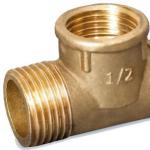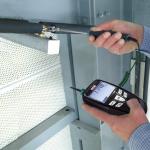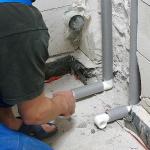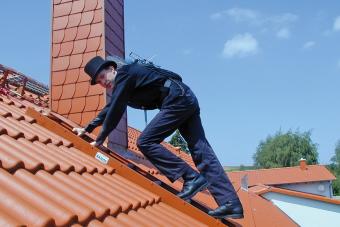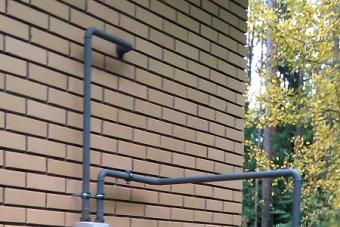Unfortunately, quite often they think about cleaning the chimney when the draft already disappears and the reverse appears - the smoke simply goes into the room. But this is already an extreme degree of clogging of the chimney. But even at the beginning of the problem, you are already breathing not only smoke that seems safe (we all go to barbecues), but also dangerous carbon monoxide. And the soot that accumulates on the walls of the chimney can even catch fire and lead to a fire!
That is why the profession of a chimney sweep has long existed and revered. And today's owners of private houses and baths are not at all afraid of cleaning the chimney - today a wide variety of special brushes are sold for this purpose, with a long handle or telescopic, round in the form of a brush with a load on a cable or more intricate ones. And believe me, there is nothing tricky in this matter!
When is it time to clean?
It will not be possible to completely do without cleaning the chimney, no matter what material and what design it is. Indeed, over time, due to soot, the passage in the chimneys narrows and the so-called reverse draft effect occurs, when the smoke no longer enters the street, but into the room. If you wait a little more time, then any furnace will simply become unusable. Not to mention that reverse draft is dangerous even for people living inside the house!
When approaching the issue of cleaning the chimney, the following factors must be considered:
- Downtime, namely how long there was no cleaning.
- What is the design of the chimney, how smooth are its walls and what are the lines of its operation.
- What kind of fuel was used, whether plastic bottles or similar garbage were thrown into the firebox.
- Was raw wood used?
- Were there pine or spruce among the firewood, because from them resinous substances settle on the wall of the chimney.
To notice that your chimney needs cleaning, you can independently by the following signs:
- Smoke color change. Ideally, if almost transparent, barely noticeable white smoke comes out into the street, and it’s bad if it becomes dark - this indicates the presence of a large amount of soot.
- Flame color change. The color of the fire in the furnace also signals problems: if it is light orange and the firewood crackles, then everything is in order. And if the flame turns dark orange, almost orange, this is a sign that the chimney needs to be cleaned.
- And, finally, the simplest and most logical way remains - a preventive inspection of the chimney. It’s good if a professional master can do this, but even you can notice problems. For example, professional chimney sweeps lower a special load into the chimney along the diameter of the pipe, and if it passes easily, everything is in order, if it rests, then it will have to be cleaned.
Moreover, the situation with soot can reach such a critical point when pollution completely blocks the chimney and ice plugs appear. And even worse - coking, when soot accumulates on the chippers and burns out there to large solid fractions, similar to coal. Such fractions clog the chimney and block the draft. And in order to remove all this, just a brush with a load will not be enough, you will have to use a special jack to raise the chimney and clean the stove. That is why it is so important to make all sections of the chimney straight. And on rare bends, install tees with a cleaning system.
In total, three types of methods for cleaning the chimney are practiced today: mechanical, with the help of special devices that need to penetrate the pipe, biological, when natural ingredients are used, and chemical, when cleaning is done using industrial special preparations. Let's dwell on each of them in more detail.

Mechanical cleaning of the chimney: only in the warm season
As a rule, ordinary owners of stoves and fireplaces clean their chimney once, before each heating season, and it's good if this is enough. And the mechanical way is the oldest and even today it makes sense:
You can manually clean the chimney both from the inside of the house, from below, and from above, directly from the roof. And for each of the methods there is a tool.
If you have chosen the brush that is used from above, you need to tie a rope to it and hook a load on it, and only then run it through the chimney through the roof. This will pass along the entire chimney and will hook soot from the walls with it. It is only important to lower the brush carefully and gradually, slowly, so that the soot is collected qualitatively and at the same time the load does not damage the chimney itself. In the same way, lower and raise the ruff several times until it becomes noticeable that the soot has been cleaned and the blockage has been broken.
Usually such a brush is enough for up to three heating seasons. But this method has its drawbacks:
- Firstly, you will need a lot of time for all this, at least an hour;
- Secondly, if you need to clean the chimney, you will not always be able to get out onto the roof, especially when it snows and the wind is strong;
- And, finally, with such a device it is quite difficult to clean the chimney elbows and hard-to-reach places, or the chimney itself is designed in such a way that it is generally impossible to clean it from the outside, through the roof.
And the method of cleaning the chimney from below, from the room, is much safer for a person. You can safely do all the necessary work and not risk your life. Simply take a brush, place it on a flexible holder and push it through a heater or a special revision hole.
In addition, from below, with the help of long flexible holders, soot is easy to clean even in high bends:

So, for example, a brush with a telescopic holder is good because it is convenient to use it on the roof: you just need to insert one part into another, gradually lowering the brush down, and disassemble it in reverse order when lifting up:

Here is a step-by-step illustration of what is needed to mechanically clean the chimney with a brush and weight:

Cleaning by folk methods: both in snow and in rain
Today, many are wondering: how to clean the chimney from soot with folk remedies in the middle of winter, without the need for mechanical cleaning, safely and reliably?
The most famous biological methods (they are usually called folk methods) are cleaning with potato peels. This method avoids the rough mechanical removal of soot from the walls of the chimney and is ideal for those areas where the heating season is long enough, because then you do not have to stop the furnace for a long time.
The second way is dry aspen wood, which burns so fast and hot that it burns all the soot in the chimney. But you need to use this method carefully so as not to actually lead to a fire.
The third relatively cheap and reliable method to extend the life of the chimney during the heating season is to sprinkle wood with salt. With each kindling, the salt binds soot and does not allow it to settle on the walls of the chimney.
You will be surprised, but even the usual, long-known in Russia, cleaning the chimney with potato peels is actually quite an effective method:
Just a little tip: if you want to clean your chimney with raw potato skins, you need to peel at least half a bucket of them. When the peel is burned, starch will remain from it, which will corrode the soot, and it will simply crumble down. After that, all the ashes will simply need to be removed from the furnace.
Dry Cleaning: Caution Needed!
But it happens that soot is difficult to clean, especially if old wood was used, and then you have to resort to a chemical method. The advantage of this method is that it will not take your time or your energy.
A variety of special products for cleaning chimneys today pleases the eye: liquids, briquettes, special powders. Their secret is that such substances are ignited in a heating device and they emit active gases, which soot is afraid of. Under their influence, it becomes fragile and begins to fall off. Moreover, some of the small particles simply fly out with the smoke, while the rest falls down and is already removed along with the ash.
Powders are simply thrown into the furnace without unpacking, directly with firewood, and there should be a lot of firewood itself. You only need to drop one sachet every two to three weeks. The only limitation of this method is that it makes sense to use powder products only if the soot on the walls of the chimney is not more than 2 millimeters. But, if you use such a powder all the time, cleaning the chimneys will not be needed at all:

But if you have a deeper problem, then you will have to use a log - this is a chemical substance in the form of a briquette, which is enough to put in the furnace once every two months, also in a package. It is used when the firewood has already burned out in order to set it on fire separately. As part of such a log, wooden files, urea, sodium sulfate, coal wax, ammonium sulfate and amorphous silicon.
Such a composition of active substances is able to remove all the accumulated soot in the chimney in just one time. After you burn the chemical log inside the firebox, for another two weeks you will have soot falling from the walls of the chimney, and it will just need to be removed.
Very convenient: just put a log on the fire, and chemical gases corrode soot not only on the surface of the walls of the chimney, but also inside the heater itself, even on the heat exchanger and the internal chimney. And in its own way, it even prevents the appearance of new soot. It is this method that allows you to remove soot in the most inaccessible places of bends and knees. And, most importantly, such cleaning can be done at any time of the year - even with an active winter firebox. The only point: if the chimney has not been cleaned for a long time, a congestion is clearly felt and there is almost no draft, then at first you will still have to use a brush.
Here is a clear example of how to clean a chimney with modern chemicals:
Professional chimney cleaning: fast, reliable and expensive
Strange as it may sound, all over the world the profession of a chimney sweep exists and is still appreciated. You will be interested to know that the traditional chimney sweep cylinder has always been the privilege of only the master. And to become one, it was necessary to serve as an apprentice for more than one year - this specialty is so complicated.
In recent years, the profession of a chimney sweep has been on the verge of extinction, and only relatively recently has it become sharply in demand. It's all about fires due to poor-quality installation of chimneys and their operation. A modern house is so expensive today that it is wiser to hire a specialist than to rely on "maybe". Indeed, it is much more logical to call a professional chimney sweep before the start of the heating season, and not a fire truck in the middle of winter.
For a long time, the All-Russian Voluntary Fire Society was engaged in cleaning the chimney, but today more private companies already offer such services. After all, the correct operation of modern chimneys requires periodic revision, cleaning and prevention. So there was such a thing as professional chimney cleaning, when special equipment is brought for such a purpose. For example, a special vacuum cleaner that simply sucks soot out of the chimney through the firebox. And then you don’t need to drag it through the whole room (and the soot is volatile and poorly washed off the furniture).
Therefore, to this day, professional cleaning is simply indispensable in the most neglected cases, when:
- the chimney is covered with a dense layer of hard soot (especially from wet firewood);
- the walls of the chimney are old and damaged, and soot tightly clings to them;
- you have no desire to do such menial work.
In practice, it looks like this:

For example, in the professional cleaning of chimneys of private houses, such special devices are used:


Modern high-speed installations cope with their task quickly enough, which completely clean the chimney in just an hour:

How to make self-cleaning tools
Special devices for cleaning the chimney from soot are sold in a regular building supermarket or specialty store, or you can make it yourself.
Let's compare a metal brush with a plastic one. Let's start with the fact that a metal brush, of course, will retain its working shape longer, but with particularly intensive cleaning it can scratch the chimney from the inside. Modern plastic brushes are soft, scratch the chimney much less, although they do not last long and at the same time easily break, losing their working shape. That is why there is an unspoken rule among summer residents: take a metal brush for a brick chimney, and plastic for a metal one. Basically, these are the following devices:

Plastic brush: short-lived, but gentle on the chimney
Making a plastic brush is as easy as shelling pears:

If you are going to build such a brush for cleaning the chimney, then all the work will take you no more than 15 minutes.
So, the usual chimney brush is a strong base with a brush, threaded through a metal wire with a load on the chain. To all this, you will need a rope along which the brush will need to be lowered into the chimney. Instead of a load and a rope, it is also quite enough to use a special holder. At least then the brush will not get stuck in the chimney and will not have to be pulled out later.
Plastic bottle brush: at no cost
Moreover, you can even make a homemade ruff from an ordinary plastic bottle (at least a few). Just 2-3 of these brushes is enough for one season. So, here's how to make such a bottle brush:
- Step 1. Make round holes in the center of the lid.
- Step 2. Cut the walls of the bottles into strips along, about 1.5 or 2 centimeters wide.
- Step 3. Make a hole in the bottom of the bottle with a heated nail and thread a 5 mm thick wire through it.
- Step 4. Now just insert one bottle into another through the cut strips and attach a thick wire to one end.
- Step 5. Put two plastic bottles on, press and fix them so that it is convenient to tie them with plastic wire.
- Step 6. Spread the cut strips of plastic evenly in a circle and secure the steel cable as it is.
The only difficulty in such manufacture is to make sure that the load and the rope (cable) are exactly in the center, and the ruff does not warp during use.
Hard round brush: the use of improvised materials
Another great option is to make such a brush from a disc brush for a grinder. Such a brush is much stronger than the previous options and will cope even with the soot itself. It is only important that the diameter of the brush is equal to the diameter of the chimney, because its bristles are hard and bend poorly:

To such a brush, you need to hang a load with a weight of about 5 kg on a steel cable, behind which you will pull the brush along the chimney. Just in case, attach another cable to the load, which will help another person from inside the room to stretch the stuck brush. It is important that the load at the same time be at least a third less than the chimney, otherwise it will catch on and if you have to tinker.
To clean the chimney with such home-made devices, you need to do this:
- Step 1. Climb onto the roof, remove the damper from the chimney and lower such a brush into the chimney to the very end.
- Step 2. Start pulling the brush back now.
- Step 3. Lower the brush down again and pull it out again.
- Step 4. All this must be done within a few minutes, keep in mind that below, inside the room, soot will pour abundantly and it must also be removed.
As you can see, everything is simple!
Asymmetric wire brush: for difficult sections of the chimney
If your chimney does not have a large length, knees, bends and is not very clogged (for example, we are talking about a chimney in a seasonal bath), then such simple devices are also suitable for its one-time cleaning:

Telescopic brush: for work from the room
Usually, as a gesture, flexible meter sticks go well, which are twisted into each other and are also called telescopic, in other words, prefabricated. Working with it is quite simple:
- Step 1. Screw the brush onto the first handle, stick it straight through the heater, push it through and clean one meter in this way.
- Step 2. The next step to the end of the handle that you are still holding and which is sticking out of the chimney, screw the second one and push the brush another meter up the chimney.
- Step 4. Repeat this whole process until you have completely cleared the entire chimney.
See how easy it is in practice:

The telescopic brush is able to penetrate the chimney very deeply:

Such a brush is significantly more expensive than the previous option, but the advantage is that such sticks usually do not break and serve for a long time. In addition, with the help of such a rigid handle it is easier to push the blockage in the chimney. In addition, this method is quite difficult to clean the soot in the knees of the chimney bends.
As for the choice of the size of the brush, everything is simple here: you need to select one according to the diameter of the chimney, preferably equal to it or 12 cm larger, so that the brush can easily catch on, and not slide along the walls, slightly not reaching them:
Let's summarize: no matter what device you use to clean your chimney yourself, the main thing is to do this cleaning regularly.
